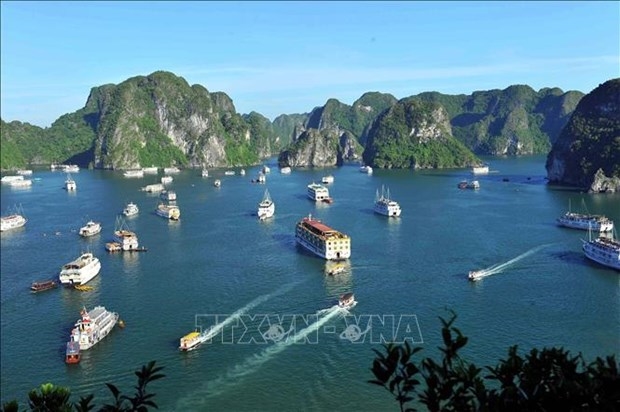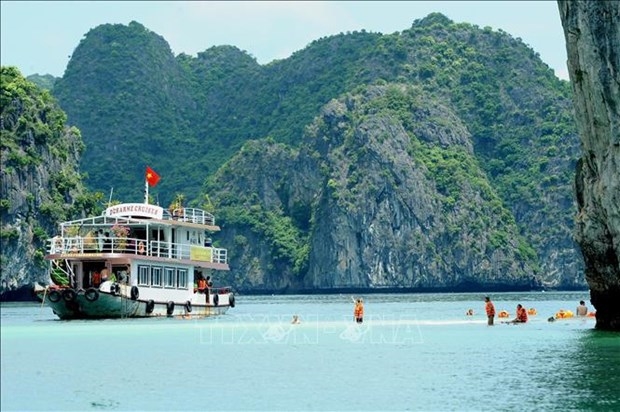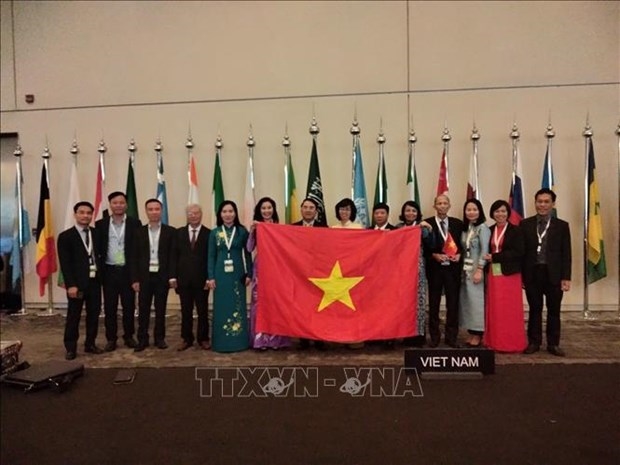 |
| Ha Long Bay in Quang Ninh province was named by UNESCO as a world heritage site twice in 1994 and 2000. (Photo: VNA) |
The United Nations Educational, Scientific, and Cultural Organization (UNESCO) announced the new inscription of the Vietnamese site to the list at the 45th session of the World Heritage Committee in Riyadh, Saudi Arabia, on September 16.
Ha Long Bay - Cat Ba Archipelago is Vietnam’s first inter-provincial UNESCO-listed world heritage site.
 |
| Cat Ba Archipelago in the northern port city of Hai Phong is the largest limestone archipelago of the country. (Photo: VNA) |
Cat Ba Archipelago in the northern port city of Hai Phong is the largest limestone archipelago of the country. It includes over 360 islands, including Cat Ba Island to the south of Ha Long Bay.
The archipelago had earlier been recognised by UNESCO as a world biosphere reserve.
Meanwhile, Ha Long Bay in Quang Ninh province was named by UNESCO as a world heritage site twice in 1994 and 2000.
According to the Ministry of Culture, Sports and Tourism, the Ha Long Bay - Cat Ba archipelago cluster boasts a rich diversity of island and ocean ecosystems. It is home to various rare animals and plants, and houses the country’s largest maritime forest with an area of more than 17,000 hectares.
It is the habitat of 4,910 species of plants and animals on land and in the sea, of which 198 species are on the International Union for Conservation of Nature's Red List of Threatened Species, 51 endemic species. The primeval forest area of about 1,045.2 ha on Cat Ba island is one of the important factors creating the ecological value and biodiversity of the heritage. In particular, the Cat Ba Langur (Trachypithecus poliocephalus) is a rare species, on the list of animals at highest risk of extinction. Up to now, there are about 60-70 individuals distributed only in Cat Ba.
In September 2016, the Prime Minister allowed Hai Phong city to work with Quang Ninh province to plan the nomination of Ha Long Bay - Cat Ba Archipelago as a world heritage site.
Ha Long Bay - Cat Ba Archipelago was added to the World Heritage List due to the beauty of its natural landscapes, including charming vegetation-covered limestone islands, breathtaking limestone islets, and impressive karst formations.
 |
| The Vietnamese delegation attends the 45th session of the World Heritage Committee in Riyadh, Saudi Arabia. (Photo: VNA) |
Ambassador Le Thi Hong Van, head of the Permanent Mission of Vietnam to UNESCO, said that the recognition affirms international appreciation for the beauty of the heritage and Vietnam's efforts to protect it. This is also another contribution of Vietnam to the heritage value preservation and promotion goal that UNESCO is promoting.
Van said that Vietnam’s world heritage sites recognised by UNESCO have been making an important contribution to local socio-economic development, as well as to environmental protection, green and sustainable growth, thereby promoting the culture, land and people of Vietnam to the world as well as enriching humanity's cultural treasure.
Before the new addition, Vietnam had eight world heritage sites recognised by UNESCO, namely Phong Nha-Ke Bang National Park in Quang Binh province, Ha Long Bay, the Hue Imperial Citadel City in Thua Thien Hue province, Hoi An Ancient Town and the My Son Sanctuary in Quang Nam province, Thang Long Imperial Citadel in Hanoi, the Citadel of the Ho Dynasty in Thanh Hoa province, and the Trang An Landscape Complex in Ninh Binh province.
Growing agricultural export to match international standards
With steady export growth, Vietnamese farm produce is increasingly meeting market demand in terms of packaging, quality and food safety, which enhances its competitiveness and allows Vietnamese products to gain further access into the global supply chain, reported Vietnam News Agency.
 |
| Processing cashew nuts for export (Photo: VNA) |
During the first months of the year to August, there was explosive growth in the export of fruits and vegetables, reaching 3.45 billion USD, up 57.5% annually. Exports are predicted to reach all-time-high of 5 billion USD this year.
This growth is expected as the Central Highlands region begins the durian harvest season.
Not only fruits and vegetables but also many others like coffee, black pepper, and rice are increasingly being monitored rigorously in terms of production, with orientations to high-quality and local signature products in order to penetrate deeper into the global market.
Notably, the Vietnamese coffee industry is making efforts to apply international standards in production and processing to access the global marketplace.
At present, the Central Highlands province of Gia Lai is home to over 36,600 ha of coffee meeting VietGAP, GlobalGAP, 4C, Organic, Rainforest Alliance standards and more than 12,086 ha of coffee using advanced irrigation technology to conserve water.
Ngo Hong Phong, Deputy Director of the National Agro-Forestry-Fisheries Quality Assurance Department, said the Ministry of Agriculture and Rural Development will continue carrying out inspections and certifications for food safety-compliant establishments and verify the certification of exported agricultural products as required by importing countries.
Deputy Minister of Agriculture and Rural Development Hoang Trung said the ministry is proposing the Government issue two more decrees on guidelines for issuing codes for growing areas and packaging facilities, and outlining sanctions and penalties in this field. This will provide an important legal basis for more stringent production management.
Travel programme promotes Hoang Su Phi terraced fields
The annual programme entitled ‘Travelling across the heritage land of the Hoang Su Phi terraced fields’ opened in Hoang Su Phi district, northern mountainous province of Ha Giang on September 16, reported Vietnam News Agency.
 |
| Terraced fields in Hoang Su Phi dsitrict, Ha Giang province. (Photo: VNA) |
Hoang Duc Tan, Vice Chairman of Hoang Su Phi district People's Committee, said that under the programme, a series of activities with many attractive tourism products will take place in the district this month, featuring typical cultural values of ethnic groups living in the northwestern region.
The terraced fields in Hoang Su Phi span more than over 3,700 hectares of 24 communes and towns in Hoang Su Phi district. They were formed hundreds of years ago by La Chi, Dao, and Nung ethnic communities.
More than 670ha of terraced fields in 11 communes have been ranked as national landscapes by the Ministry of Culture, Sports and Tourism./.